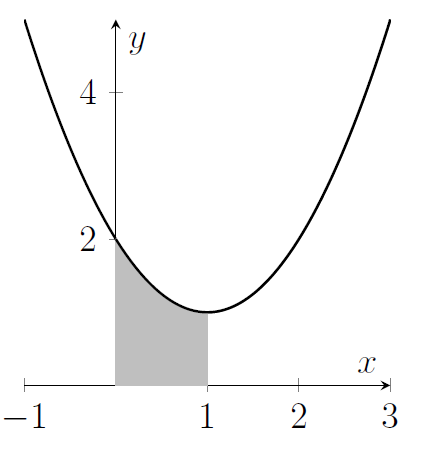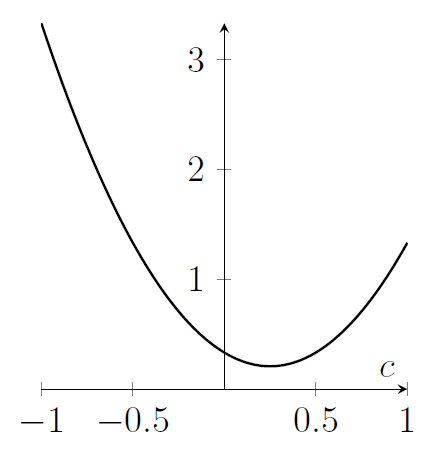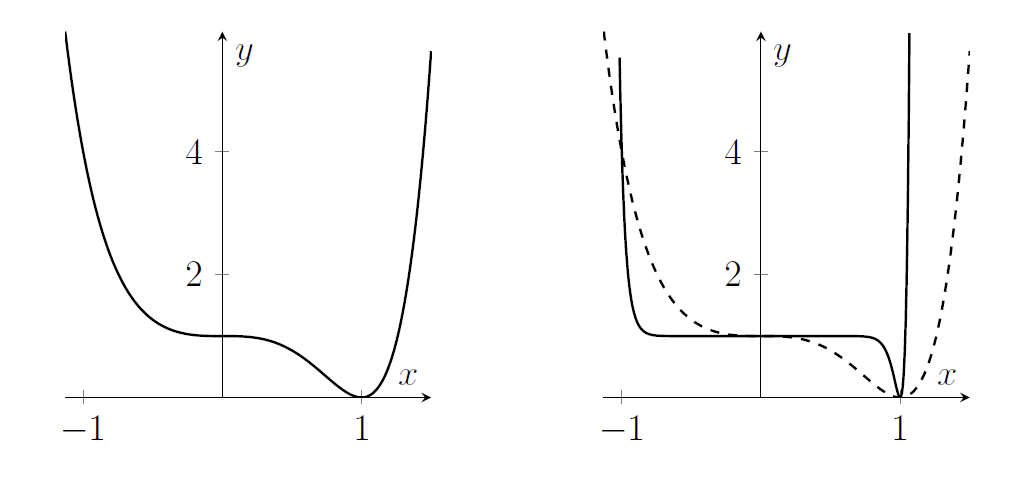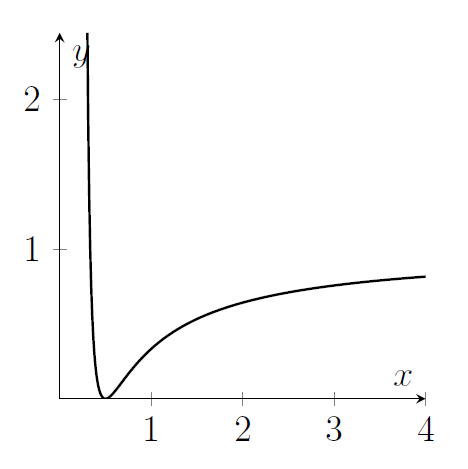Integration Solutions
Part of the Oxford MAT Livestream.
Revision Questions
- The derivative of $x^a$ is $ax^{a-1}$ so the derivative of this expression is $17x^{16}+17x^{-18}$.
- Remember that $\sqrt{x}=x^{1/2}$ and $\sqrt[3]{x}=x^{1/3}$, so the derivative of this expression is $x^{-1/2}+x^{-2/3}$, which we could write as \(\displaystyle\frac{1}{\sqrt{x}}+\frac{1}{x^{2/3}}\) if we wanted to.
- Remember that the derivative of a constant is $0$, so the derivative of this expression is just $-3e^{3x}$.
- We need to find the value of the derivative $\displaystyle\frac{\mathrm{d}y}{\mathrm{d}x}$ at $x=2$ because that's equal to the gradient of the tangent. We can differentiate to find $\displaystyle\frac{\mathrm{d}y}{\mathrm{d}x}=e^x+2x$ so that gradient we wanted is $e^2+4$. We also want the tangent to have the same value at $x=2$ as the curve; that's $e^x+x^2$ at $x=2$, which is also $e^2+4$. So our tangent is $y=(e^2+4)(x-1)$.
- First find the derivative at $x=3$, which is $6$ for this parabola. That's the gradient of the tangent, and the normal is at right-angles to the tangent, so it has gradient $\displaystyle -\frac{1}{6}$. We have $\displaystyle y=-\frac{x}{6}+c$ and we want the normal to go through the point $(3,9)$. So we want $\displaystyle c=\frac{19}{2}$.
- The turning points must have $\displaystyle\frac{\mathrm{d}y}{\mathrm{d}x}=0$ so we must have $4x^3-6x^2+2x=0$. That happens when $x=0$ or when $2x^2-3x+1=0$ which happens when $(2x-1)(x-1)=0$, which is either $x=1$ or $x=\frac{1}{2}$.
Now find the second derivative to check whether these are minima or maxima. We have $\displaystyle \frac{\mathrm{d}^2y}{\mathrm{d}x^2}=12x^2-12x+2$, which is positive for $x=0$, negative for $x=\frac{1}{2}$, and positive for $x=1$. So we have a (local) minimum, then a (local) maximum, then a (local) minimum.
The function is decreasing for $x<0$, then increasing for $0<x<\frac{1}{2}$, then decreasing for $\frac{1}{2}<x<1$ then increasing for $x>1$. - The line definitely goes through $A$, which doesn't move. The thing we learn from ``differentiation from first principles" is that the gradient of the line gets closer and closer to the derivative of the function at $A$.
The derivative is $3x^2+2x+1$ which is 6 at $x=1$. The value is $4$, so the tangent is $y=6x-2$. So if the line through $A$ and $B$ is $y=mx+c$ then $m$ gets closer and closer to 6 and $c$ gets closer and closer to $-2$. - First find the points where $y=0$. We have $(x+3)(x+1)=0$ so these points are at $x=-1$ or $x=-3$. In between, we have $y<0$ (by considering the graph).
So we want $-\displaystyle \int_{-3}^{-1} x^2+4x+3\,\mathrm{d}x$. That minus sign out the front is because the function is negative in this region. This works out to be $\displaystyle \frac{4}{3}$. -
- $\displaystyle \int \frac{x+3}{x^3}\,\mathrm{d}x=\int \frac{1}{x^2}+\frac{3}{x^3},\mathrm{d}x=-\frac{1}{x}-\frac{3}{2x^2}+c$ where $c$ is a constant.
- $\displaystyle \int \sqrt[3]{x}\,\mathrm{d}x=\int x^{1/3}\,\mathrm{d}x=\frac{3}{4}x^{4/3}+c$ where $c$ is a constant.
- $\displaystyle \int \left(\left(x^2\right)^3\right)^5\,\mathrm{d}x=\int x^{30}\,\mathrm{d}x=\frac{x^{31}}{31}+c$ where $c$ is a constant.
- $\displaystyle \int \left(x^2+1\right)^3\,\mathrm{d}x=\int x^6+3x^4+3x^2+1\,\mathrm{d}x=\frac{x^7}{7}+\frac{3x^5}{5}+x^3+x+c$ where $c$ is a constant.
- The graph of $f(-x)$ is the graph of $f(x)$ reflected in $y$-axis. Also, note that if we reflect the interval $-1\leq x \leq 1$ in the $y$-axis then we get the same interval back. On the left-hand side, we're finding the area under $f(x)$ (or maybe negative the area in any regions where $f$ is negative). On the right-hand side, we're calculating exactly the same area, but with the shape of the graph reflected.
- First consider the graph $\displaystyle y=\frac{1}{x}$. The area under the graph between $x=1$ and $x=10$ is $I_1$. Now consider stretching that region by a factor of 10 parallel to the $x$-axis, and squashing it by a factor of 10 parallel to the $y$-axis. The area will be the same, and (amazingly!) any point that was on the curve $\displaystyle y=\frac{1}{x}$ is still on the graph after these transformations. So $I_2$, the area under the graph between $10$ and $100$ is equal to $I_1$.
This means that $$\int_1^{100}\frac{1}{x}\,\mathrm{d}x=\int_1^{10}\frac{1}{x}\,\mathrm{d}x+\int_{10}^{100}\frac{1}{x}\,\mathrm{d}x=I_1+I_2=2I_1.$$
But similarly, if we think about stretching the graph again in the same way, we find that $\displaystyle \int_{100}^{1000}\frac{1}{x}\,\mathrm{d}x$ is also equal to $I_1$. By setting $N$ to be a large power of ten, we can make $\displaystyle \int_1^{N}\frac{1}{x}\,\mathrm{d}x$ arbitrarily large. - Note that $\displaystyle \frac{x^2}{1+x^2}+\frac{1}{1+x^2}=1$ so $I_3+I_4=\int_1^3 1 \,\mathrm{d}x=2$. So $I_3+I_4=2$.
- Note that $\displaystyle \frac{x^4}{1+x^2}=x^2-\frac{x^2}{1+x^2}$ so this new integral is $\displaystyle \int_1^3 x^2\,\mathrm{d}x-I_4=8\frac{2}{3}-I_4$.
MAT Questions
MAT 2007 Q3
(i) This quadratic has a turning point at $(1,1)$ and a positive coefficient of $x^2$. The $y$-intercept is 2. Here's my sketch;

(ii) $(x-c)^2$ is positive or zero, and $c^2$ is positive or zero, so $(x-c)^2+c^2$ is positive or zero. The integral of a function $f(x)\geq 0$ is positive or zero, because the integral is the area under the curve.
(iii) We have$$I(c)=\int_0^1 x^2-2cx+2c^2\,\mathrm{d}x=\frac{1}{3}-c+2c^2$$
(iv) Differentiate this quadratic with respect to $c$; the minimum occurs when $4c-1=0$, which is when $c=\frac{1}{4}$. The value of $I\left(\frac{1}{4}\right)$ is $\frac{5}{24}$.
(v) Remember that $-1\leq \sin \theta<1$. Let's sketch the quadratic $2c^2-c+\frac{1}{3}$ against $c$ for $-1\leq c \leq 1$

This quadratic has a minimum in this interval, so we check the ends of the interval for a maximum. $ I(1)=\frac{4}{3}$ and $ I(-1)=\frac{10}{3}$. The maximum value of $I(\sin \theta)$ is therefore $ \frac{10}{3}$.
Extension
- This is a translation of $x^6+x^2$. That function has a minimum at $x=0$ and increases away from $x=0$. We can make the integral from 0 to 1 small by choosing $c=1/2$.
- First suppose that $a\geq 0$. In this case, the quadratic has a minimum turning point (or no turning point if $a=0$), so we compare the values at $-1$ and $1$. These are $a-b+c$ and $a+b+c$. So there are two sub-cases; if $b\geq 0$ then the maximum value is $a+b+c$, but if $b<0$ then the maximum value is $a-b+c$.
However, if $a<0$ then the maximum might occur at the turning point where $2ax+b=0$, provided that $-1\leq -b/2a \leq 1$. We should check the value at this turning point; it's $c-\frac{b^2}{4a}$. Depending on whether this is larger or smaller than $a-b+c$ or $a+b+c$, this could be the maximum value.
MAT 2009 Q3
(i) The function inside the brackets is $x^3-1$. That's $0$ at $x=1$ and it's $-1$ at $x=0$. It's negative for $x<1$. Here's my sketch of the square of that function, on the left below.

(ii) For higher powers of $n$, the function $x^{2n-1}$ is approximately zero for $|x|<1$, and it grows rapidly outside that range. So $x^{2n-1}-1$ is about $-1$ for the range $|x|<1$, but it shoots up to high positive values soon after $x=1$ and it shoots down to very negative values just before $x=-1$. If we square that function, we'll get something that's about $1$ for most of the range $|x|<1$, but near the edges of that region two strange things will happen. Near $x=-1$, the function inside the brackets just gets really negative. For $x$ near $1$, the function inside the brackets increases to zero then increases to high positive values. For the square of the function, this is a decrease to zero first, then an increase to high positive values. See my sketch above, on the right, with the dashed line indicating my previous sketch.
(iii) We have $$ \int_0^1 f_n(x)\,\mathrm{d}x=\int_0^1 x^{4n-2}-2x^{2n-1}+1\,\mathrm{d}x=\left[\frac{x^{4n-1}}{4n-1}-\frac{x^{2n}}{n}+x\right]_0^1=\frac{1}{4n-1}-\frac{1}{n}+1$$
where the contributions from the lower limit $x=0$ are all zero because those powers of $x$ give zero for $n\geq 1$ a whole number.
(iv) We would like
$$ 1+\frac{1}{4n-1}-\frac{1}{n}\leq 1-\frac{A}{n+B}$$
for all $n\geq 1$. This rearranges (being careful not to multiply by negative numbers) to the inequality
$$
0\geq (4A-3)n^2+(1-A-3B)n+B
$$
If the coefficient of $n^2$ is positive, this clearly doesn't work (because the right-hand side will get really large and positive for large enough $n$), so we must have $A\leq 3/4$.
(v) If the coefficient of $n^2$ is zero, then $A=3/4$. We still need $$ 0\geq \left(\frac{1}{4}-3B\right)n+B$$ for all $n\geq 1$. For this to work, the linear function on the right-hand side must have negative or zero gradient, and the value at $n=1$ must be negative or zero. We therefore require both $B\geq 1/12$ and also $B \geq 1/8$. Since we need both of these to hold, we must have $B\geq 1/8$.
Quick check that if $A=3/4$ and $B=1/8$ then the inequality is in fact true.
Extension
- If $n=1/2$ then the function is constant and zero. The integral is zero.
- We need $n> 1/4$. If $n\leq 1/4$ then the integral doesn't exist, because $x^{4n-1}$ gets very large near $x=0$.
- Sketch:


